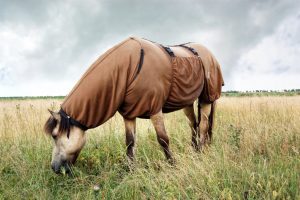
The importance of good timing when it comes to sweet itch!
We cannot stress it enough: start treating sweet itch in good time. Do not start only once your horse is already displaying symptoms of itching, but start as soon as the weather turns warmer. Last week, the temperature even reached around 16 °C and the first flies and midges appeared straight away (yes, despite that period of freezing cold weather). Start treating sweet itch when the temperature rises above 10 °C. Keep a close eye on the temperature and start on time. Better too early than too late. This article will explain why this is so important.
Downward spiral
When a horse is bitten by a Cullicoides midge, the saliva causes a great deal of itching in horses, which are allergic to it. A very logical response is for horses to start scratching. However, horses often do not stop scratching but instead continue even until they get sores. That is the point at which a horse entered a downward spiral. Because then not only does the midge bite itch, the wounds that are trying to heal also start itching. Even more itching means even more scratching.
Immune system & circulation
Treating sweet itch involves a great deal more than preventing midge bites. For example, did you know that there is a link between sweet itch and horses’ immune systems and circulation?
Link with the immune system (waste)
A horse that is no longer able to eliminate waste effectively, or has a high volume of accumulated waste, can process the substances in the saliva of a Cullicoides midge less effectively. It is therefore advisable to detoxify (cleanse of waste) your horse before the sweet itch season in summer. That way, you make your horse more resilient to the saliva of the midges. In addition, products taken internally such as Finecto+ Horse work better. A detox is best carried out in spring or autumn (before and after the itch season in summer).
There are various detox products with different names on the market. Detoxification is also known as clearing, cleansing and purifying. Essentially, it comes down to products that optimise liver and kidney function.
Link with circulation
There also appears to be a link between sweet itch and the body’s circulation. Movement promotes circulation and thus the elimination of waste. A horse with sweet itch should therefore be given as much exercise as possible. Exercising in the field is not sufficient. Allow a horse daily exercise. As little as twenty minutes of walking on the rein can help.
In addition, there are now also special blankets that promote circulation by means of infrared technology. These blankets are a rather recent invention, so there are no recorded experiences of use on horses with sweet itch to draw from yet. Do you have one of these blankets for your racehorse? Place it over your horse regularly if it is sensitive to sweet itch. A small effort could be a useful part of your total strategy against sweet itch.
Comprehensive strategy against sweet itch
There is no single product that offers a complete solution. You can only get sweet itch under control if you adopt a comprehensive strategy. This entails the following:
- Detoxification of the horse’s system
Ensure your horse’s immune system is optimal. Detoxify the horse’s system before and after the sweet itch season with therapy that lasts at least a month.
- Start using an sweet itch blanket early
An sweet itch blanket can easily be worn under a rain sheet. An sweet itch blanket on its own is not sufficient for preventing sweet itch in summer, but it is an indispensable part of the total strategy.
- Start with Finecto+ Horse as soon as the temperature rises above 10 °C
Finecto+ Horse makes your horse unappealing to midges. An sweet itch blanket does not cover the whole of the horse’s body, but a supplement such as Finecto+ Horse does.
- Limit sugars in the diet
Sugars are found not only in concentrated feed, but in raw feed and grass too. Check your raw feed for sugar and do not put your horse out in the field the morning after a cold night. Apply strip-grazing to ensure your horse can enjoy the grass section by section.
- Allow your horse daily exercise
Exercise in the field is not sufficient. Walk with your horse for at least twenty minutes every day.
- Put your horse in the stable at dusk
Midges are most active at twilight. It is therefore advisable not to let your horse out of the stable too early or return it to the stable too late.
- Ensure your horse’s weight is optimal
Being overweight or underweight can have a negative effect. Start adjusting the rations and, if necessary, the workload in good time. Bear in mind that it can take months for a horse to lose or gain weight.
In short, be disciplined in your approach and think ahead. When treating summer sweet itch, not only is it important to treat your horse externally, but also to assess your horse’s rations critically. It is important to unburden the immune system as much as possible and to optimise your horse’s metabolism and intestinal flora. Good luck!




